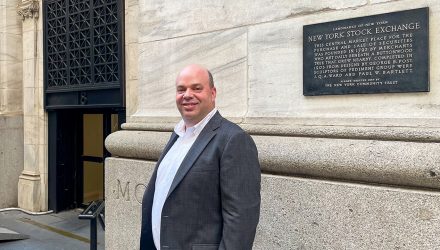It seems like every day a new ETF launches, but 30 years in, it’s only rarely that one makes me say “yes, this makes sense, and I can see how the ETF could fit into a broader portfolio.” But the Roundhill Big Bank ETF (BIGB) (covered here) is one of those funds — and no, this is not a recommendation to purchase it, but an attempt to put the fund in perspective.
BIGB is providing exposure to the six largest banks — Bank of America, Citigroup, Goldman Sachs, JPMorgan, Morgan Stanley, and Wells Fargo — in a targeted ETF for a 0.29% fee. For efficiency, BIGB is using options contracts rather than owning the stocks directly, but there is no leverage involved.
Some advisors who gain exposure to U.S equities with broadly diversified ETFs like the SPDR S&P 500 ETF (SPY) might believe that largest cap U.S. banks are positioned to benefit from the U.S. regional banking crisis and the issues that forced Credit Suisse to merge with UBS. If they do, they could own Bank of America or JPMorgan shares directly, or maybe own one of more than a dozen financial ETFs.
Owning an individual stock comes with risks, of course; just think back a couple of years to when Wells Fargo was out of favor relative to the industry. There are benefits to a more diversified approach using ETFs.
VettaFi has certainly seen recent investor demand to learn about financial ETFs. Indeed, in mid-March, approximately 50% of the traffic to our U.S. sector-specific pages was for financials, up from just 7% a month earlier.
But the larger financial ETFs provide different exposure than BIGB. For example, the Financial Select Sector SPDR ETF (XLF) had just 24% of assets as of March 17 invested in banks. While JPMorgan and Bank of America were the second-largest holdings, at 8.7% and 4.6% of assets respectively, the largest position (13% of assets) was in Berkshire Hathaway, and newly added sector constituents Visa and Mastercard were 8.5% and 7.0% of the fund. Visa and Mastercard joined as part of the latest GICS shakeup.
Meanwhile, the more targeted bank ETFs — SPDR S&P Bank ETF (KBE) and the Invesco KBW Bank ETF (KBWB) — are not providing the concentrated exposure to the mega-cap banks advisors might be seeking. KBE takes an equally-weighted approach, so while JPMorgan is a top-five position, it is only 1.7% of the assets, with smaller-cap companies like BankOZK representing a similar slice of the portfolio.
KBWB is more concentrated toward large-cap banks than KBE, with JPMorgan the largest at 9.5% of assets, but KBWB’s top-6 holdings represented 48% of assets with Northern Trust and US Bancorp taking the place that Goldman Sachs and Morgan Stanley have within BIGB. Other companies like Capital One Financial, M&T Bank, and State Street were also a key part of the KBWB portfolio.

Both KBE and KBWB charge 0.35% expense ratios, while XLF had a more modest 0.10% fee.
The above, and other financial ETFs, have the advantage of being more diversified than BIGB, which will rise and fall in value based on sentiment to a handful of mega-cap U.S. banks. In addition, the more established funds will have greater initial liquidity and trade, with tighter spreads than a new ETF. However, we could see this new bank ETF throw its weight around and garner attention.
For more news, information, and analysis, visit VettaFi | ETF Trends.
